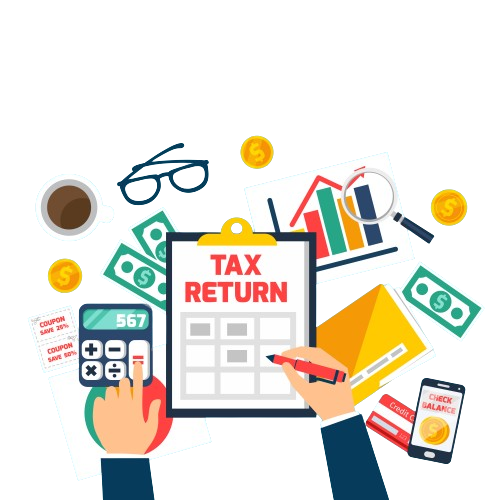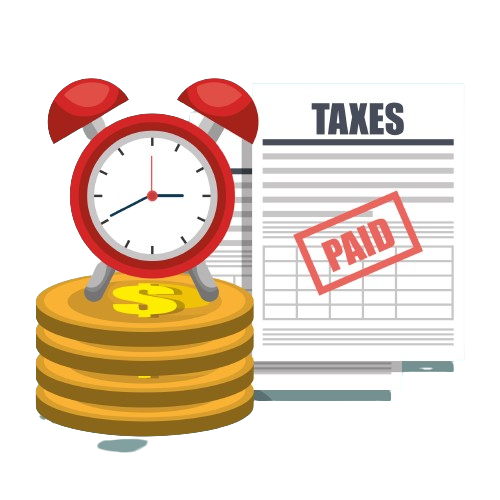Income Tax Notice
Got an income tax notice?
You don't need to stress over it. GoVyapar is here to help.
Addressing an income tax notice couldn't get easier!

Are you filing an IT return because of the following reasons?
Before worrying about an income tax notice from the tax department, you should know whether you are required to file a return. Here are the reasons you should do it:
- Income exceeding the basic exemption limit
- More than Rs. 1 crore deposited in 'current' bank account
- More than Rs. 50 lakh deposited in 'savings' bank account
- TDS or TCS is exceeding Rs. 25,000
- Business turnover exceeding Rs. 60 lakh
- Professional income exceeding Rs. 10 lakh
- Electricity expenditure exceeding Rs. 1 lakh
- Spending more than Rs. 2 lakh on international travel

When May Tax Payers Get An Income Tax Notice
Did you know that you can get an income tax notice for various reasons? Here are a few possibilities you should be aware of:
- Failing to file your ITR
- Not disclosing income or a part of it
- Errors or discrepancies in your returns
- TDS values and filed income tax returns show a mismatch
- Need to provide specific documents or information
- Investing in the spouse's name and not mentioning it in ITR
- Potential audit under section 143(1) of the IT Act
- Not reporting high-value transactions in the return
- Failing to report capital gains/losses from equity/debt investments
- Using a wrong income tax return form
- Tax evasions in previous financial years
- Income tax notice on not reporting sale/purchase of property
- Liability for the self-assessment tax
- Another other reason an assessing officer deems fit
- Mismatch with AIS/TIS
Income Tax Notice- Types of ITR Notices
A notice from the Income Tax Department is the last thing you want to deal with. But it is more common than you imagine. Whether you are a salaried professional, self-employed individual, or business owner, knowing about the different types of ITR notices can save you from stress down the road. Awareness makes it easy to comprehend a notice and seek help from an expert. No matter how daunting the situation is, a seasoned tax expert can be your savior. Here are a few types of IT notices you may expect.
BASIC NOTICES:
Notice under section 131
The assessing officer may serve a notice under this section if they consider that the taxpayer has concealed their income as a whole or a part thereof.
Notice sent under Section 139(9)
Filing a defective income tax return can land you an ITR notice under section 139 (9). Beware of errors such as missing information and the selection of the wrong ITR form.
Notice under Section 142(1)
You can expect an IT notice for a preliminary investigation if the AO finds a mismatch between your ITR and the information available to them.
Intimation under Section 143(1)
YAll taxpayers get an intimation u/s 143(1) as it is a computer-generated initial assessment. Rather than being a demand notice, it may show a potential refund.
Notice under Section 143(2) for scrutiny assessment u/s 143(3)
If the Tax Department wants to scrutinize your ITR, it will send you a notice u/s 143(2). You may get it within six months from the end of the financial year.
Get Expert Guidance:
Notice under Section 148
You may receive this type of notice if the assessing officer thinks that you have filed your ITR on a lower income or failed to file when the law mandated it.
Notice under Section 156
A notice under Section 156 is a reason to worry because it replicates a demand by the income tax department, such as a penalty, fine, tax, or any other dues.
Notice under section 245
Expect a notice under section 245 if the assessing officer finds that you have missed out on the tax payment for the previous financial year.
High-Value Transaction (HVT) Notice
A massive financial transaction such as a large cash deposit or property purchase can raise a red flag and lead to an IT notice.
Risk Management Notice
An issue like the omission of income, deductions claimed, or confirmation of refund claims causes tax authorities to serve a notice for rectification of these concerns.
Form 67 Defects
Have you claimed a deduction for the income of foreign companies? You may get a notice if the department finds errors in the submitted Form 67.
26AS-AIS/TIS Mismatch
A mismatch between 26AS and AIS/TIS can fetch you a notice because the department seeks clarification to ensure proper credit of taxes paid.
RELIEF 90/90A/91
Taxpayers receiving foreign income can claim relief under this provision to avoid double taxation. But they may get a notice to validate the claim.
CALLING FOR INFORMATION AND SCRUTINY NOTICES
Information and scrutiny notices arise from previous filings and require verification of such claims in tax returns. These include:
Information Requests
The IT department may send a notice to taxpayers to verify certain details or claims in previous tax filings.
Limited Scrutiny
Limited scrutiny refers to the in-depth checks of certain aspects of the tax return, requiring the taxpayer to provide additional documentation or explanations.
Full Scrutiny
A full scrutiny entails the comprehensive examination of the entire tax return to verify the accuracy and authenticity of a claim.
APPEAL AND EX-PARTE ORDER NOTICES
A disagreement between the taxpayers and tax authorities on tax-related decisions leads to an appeal. It entails a legal process to resolve the dispute and ensure fairness. Appeal cases can play a key role in interpreting tax laws and setting precedents for future cases.
A taxpayer can file appeals for different reasons, such as:

- Ex-Parte Orders
- Incorrect penalty raised by the IT department
- Incorrect Demand raised by department
- Rectification not considered
- Apparent mistake from record
- Any disallowance by CPC true to the fact
Appeal filing start with CIT(A). After an unfavourable outcome here, the taxpayer can file another one at the ITAT Tribunal and more at the High Court and Supreme Court if rejected every time. Once appeal is filed, you should respond to each and notice under :"E-Proceedings" Tab. Failure to respond an get you an Ex-Parte order.
Notices include:
Appellate Notices
When someone disagrees with a decision of the department and wishes to file an appeal, they can expect an appellate notice.
Ex-Parte Orders
These notices indicate that a decision has been made without a person’s individual participation or compliance.
Seeking Rectification
Rectification notices seek the correction of errors or omissions in previous proceedings by submitting supporting documents.
PRICING PLAN
Plans Based On Your Selection
Appeal Cases
₹25,399
Inclusive of Taxes
- For 1st & 2nd Appeal
- Appeals that can be conducted through online tax portals, without requiring a physical visit
- ITAT Appeals will be charged separately, depending upon location & availability of tax consultant
- For cases where you cannot proceed with simple Rectification, Revise Return, Feedback
Rectification / Revised / Defective
₹2,499
Inclusive of Taxes
- Applicable to rectifying defects, revisions, adjustments, HVT Notice, adjustments, Form 67 defects,26AS-AIS/TIS Mismatch etc.
- Major overhauls or replacements beyond basic rectification
- If the ITR plan fee is higher than the Notice fee, the higher of the two fees will be applicable
- Full payment upfront
- We aim to complete the service within 4 business days from the date of receiving the notice with all related documents
- This pricing plan covers a two-time rectification / revise / defective service for each eligible customer.
Routine Notice
₹899
Inclusive of Taxes
- For providing a simple response and cross checking your filed ITR.
- Applicable for Risk Management Notices, Refund Re-issue, Simple Response to outstanding demands, E-Campaign Response etc
- For revise filing due to omission of income or taken incorrect deductions, plan will change accordingly
- For Agree/Disagree Responses.
Scrutiny Cases
₹21,199
Inclusive of Taxes
- Comprehensive services for scrutiny cases, including document review, preparation of responses.
Calling For Information/Seeking Clarification
₹6,399/year
Inclusive of Taxes
- Financial Transactions
- Deductions
- F&O Trades
- Unreported Income
- Misreported/ Underreported Income
Scrutiny Cases (ITR Filed By GoVyapar)
₹12,699/year
Inclusive of Taxes
- Special rate for scrutiny cases where GoVyapar has already filed the Income Tax Return (ITR) on behalf of the client for that particular A.Y. only.
How to Deal With an Income Tax Notice
Have you got an income tax notification? Stay calm because a notice is not always a reason to stress about. Here are the steps to deal with a notice effectively:
Read the notice:
You should understand what it means and why it has been sent in the first place
Check details:
Dig deep to check if the notice has your correct name, address, PAN number, and assessment year
Look for discrepancies:
Find out the reason for the notice being served by checking your income tax return for discrepancies
Respond to the ITR notice:
Since there is an income tax notice time limit, responding before the deadline can save you from penalties and prosecutions
Seek expert help:
Professional help is essential to ensure that your response is accurate and backed by adequate information
Why Choose GoVyapar as Your Guide


At GoVyapar, we offer reliable tax planning expertise with a few clicks.
- A copy of the notice
- TDS certificates (Form 16- Part A)
- Proof of Income source (Salary receipts, Form 16- Part B, etc)
- Investment Proof
Frequently Asked Questions
What is an Income Tax Notice?
An Income Tax Notice is a communication from the Income Tax Department to the taxpayer for various reasons. The reasons may be related to: discrepancies in the ITR filed, requests for additional documents, or requests for taxpayer’s personal appearance. Income Tax Notices can be issued under various Sections of the Income Tax Act, and each Notice specifies the purpose for which it is issued, alongwith the response expected from the taxpayer.
Receiving an Income Tax Notice may not always be a reason to worry. However, it does require an accurate and timely response to address the issue raised by the Income Tax Department.
How do I check my tax notice?
An IT notice is delivered to the taxpayer’s registered email. It can also be checked through the income tax notification portal. However, the portal offers information only on some of the notices. For others, you have to visit the IT department. Remember to check the authenticity of the notices by using a quick link for “Authenticate notice/order issued by ITD” on the Income Tax website. At this point, it is also crucial to know your DIN to facilitate communication with the IT department.
Does a salaried person get an income tax notice?
Salaried professionals can also get an income tax notice. Most notices come up when there is a mismatch with 26AS/AIS/TIS or any omission of income.
What to do if I get a tax notice?
Although an income tax notification can be stressful, you should stay calm and understand why it has been sent. If you have received it for missing out on information, you need to provide the details. Conversely, you will have to rectify errors if they are the reason for getting a notice. You must respond to the notice within the stipulated time to avoid possible penalties.
What happens if you don't respond to the tax notice?
Not responding to the income tax notice may have different consequences according to the type of notice. Such consequences include penalties of up to INR 10,000 and imprisonment for up to one year.
What happens if I don't respond to the notice within 30 days?
Failing to respond to the notice within 30 days can get you in trouble. The IT department will adjust the outstanding demand without giving you an opportunity to respond.
How do you reply to notice?
Replying to an income tax notice is easy as you can do it online by visiting the official website of the income tax department. Log in, navigate to the compliance section, and respond to the notice.
What is an intimation letter from income tax?
An intimation order/notice is issued by the income tax department under section 143(1) after the successful processing of your return. It includes the details of the information submitted at the time of tax filing and a corresponding column of the details available with the tax department. This intimation is sent within a year from the end of the financial year.
What does the code EXC 001 mean?
EXC -001 means transactions beyond the permission of the IT Act. It is for monthly cash transactions higher than INR 10 lakh.
Do I get notices for current account transactions?
Yes, you may get ITR notices for current account transactions. For example, any current bank account transaction exceeding Rs 50 lakhs in a financial year has to be disclosed. If you fail to do it, you may get notice for it.
What is the communication of the proposed adjustment u/s 143(1)(a)?
It refers to any information by the IT department regarding adjustment against refund claimed in your income tax return, such as incorrect claim, arithmetical error, or disallowance of loss claimed. Such adjustment could relate to the outstanding demands of previous assessment years.
How can you rectify the discrepancy in u/s 143(1)?
If any demand raised in the discrepancy in notice u/s 143(1) is correct, you should pay it. Conversely, you should file rectification u/s 154 (1) or a revised return if a mistake is apparent from the record. For a revision, click ‘e-file’ and choose ‘file income tax return’. For rectification, click ‘services’ and select the ‘rectification’ option from the menu.
How do I pay my tax on demand?
Paying online is an easy way to clear your tax on demand. You can do it by accessing the e-filing website of the IT department and logging into your account. Check the amount of outstanding tax demand and pay directly under the "Response to Outstanding Tab" on the web portal.
How do you correct outstanding tax demand?
Once again, you can do it by logging in to the official efiling website, going to the pending actions section, and selecting Response to Outstanding Tax Demand.
How long after filing tax returns can you expect an assessment notice?
You can get a scrutiny assessment notice u/s 143(2) only up to six months from the end of the financial year.
How do I get my CPC income tax return?
You get an ITRV (acknowledgment) on your registered mail ID soon after filing the ITR. You can also download it from your account on the official website.
Subscribe to us!
Subscribe to our newsletter for exclusive updates and offers.
GET IN TOUCH
- +91-9808030923
- support@govyapar.com


